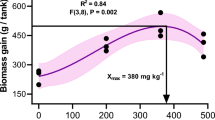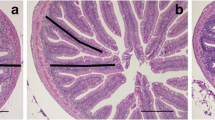Abstract
The present experiment shows that ascorbate-2-sulfate (AS) is not equivalent to ascorbic acid (AA) as a dietary vitamin C source for Atlantic salmon (Salmo salar). Within reasonable feed supplemental levels AS does not provide the tissues with adequate supplies of vitamin C to secure optimal physiological functions as demonstrated by biochemical and haematological analyses.
AS could not be detected in the liver of fish fed either AA or AS, nor in vitamin C — deprived salmon, suggesting that AS is not the natural storage form of vitamin C in this species.
There were no significant differences in antibody production against a soluble artificial antigen (NIP11-LPH) in fish fed 500 and 5000 mg AA/Kg dry diet or equivalent amounts of AS during a period of six weeks at a water temperature of 7.2°C.
Similar content being viewed by others
References cited
Albrektsen, S., Lie, Ø. and Sandnes, K. 1988. Ascorbyl palmitate as a dietary vitamin C source for Rainbow trout (Salmo gairdneri). Aquaculture 71: 359–368.
Baker III, E.M., Hammer, D.C., March, S.C., Tolbert, B.M. and Canham, J.E. 1971. Ascorbate sulfate: A urinary metabolite of ascorbic acid in man. Science 173: 826–827.
Bell, G.R., Higgs, D.A. and Traxler, G.S. 1984. The effect of dietary ascorbate, zinc, and manganeseon the development of experimentally induced bacterial kidney disease in Sockeye salmon (Oncorhynchus nerka). Aquaculture 36: 293–311.
Benitez, L.V. and Halver, J.E. 1982. Ascorbic acid sulfate sulfohydrolase (C2 sulfatase): The modulator of cellular levels of L-ascorbic acid in rainbow trout. Proc. Natl. Acad. Sci. 79: 5445–5449.
Blazer, V.S. 1982. The effect of marginal deficiencies of ascorbic acid and alpha-tocopherol on the natural resistance and immune response of rainbow trout (Salmo gairdneri). Ph.D. dissertation. University of Rhode Island, U.S.A.
Durve, V.S. and Lovell, R.T. 1982. Vitamin C and disease resistance in channel catfish (Ictalurus punctatus). Can. J. Fish. Aquat. Sci. 39: 948–951.
Espelid, S., Hjelmeland, K. and Jørgensen, T. 1987. The specificity of Atlantic salmon antibodies made against the fish pathogen Vibrio salmonicida, establishing the surface protein VS-P1 as the dominating antigen. Develop. Comp. Immun. 11: 529–537.
Halver, J.E., Smith, R.R., Tolbert, B.M. and Baker, E.M. 1975. Utilization of ascorbic acid in fish. Ann. N.Y. Acad. Sci. 258: 81–102.
Hilton, J.W., Cho, C.Y. and Slinger, S.J. 1978. Effect of graded levels of supplemental ascorbic acid in practical diets fed to rainbow trout (Salmo gairdneri). J. Fish. Res. B. Can. 35: 431–436.
Hornig, D. 1975. Distribution of ascorbic acid, metabolites and analogues in man and animals. Ann. N.Y. Acad. Sci. 258: 103–118.
Hornig, D., Glatthaar, B. and Moser, U. 1984. General aspects of ascorbic acid function and metabolism. In: Ascorbic acid in domestic animals. pp. 3–24. Edited by I. Wegger, F.J. Tagwerker and J. Moustgaard. The Royal Danish Agricultural Society, Copenhagen.
Killie, J-E.A. 1987. Humoral immunrespons hos Atlantisk laks (Salmo salar) studert ved hjelp av haptenisert antigen, M.D. Thesis, University of Tromsø, Norway (in Norwegian).
Kuenzig, W., Avenia, R. and Kamm, J.J. 1974. Studies on the antiscorbutic activity of ascorbate 2-sulfate in the Guinea pig. J. Nutr. 104: 952–956.
Landolt, M.L. 1989. The relationship between diet and the immune responses of fish. Aquaculture (in press).
Li, Y. and Lovell, R.T. 1985. Elevated levels of dietary ascorbic acid increase immune responses in Channel catfish. J. Nutr. 115: 123–131.
Lie, Ø., Waagbø, R. and Sandnes, K. 1988. Growth and chemical composition of adult Atlantic salmon (Salmo salar) fed dry and silage based diets. Aquaculture 69: 343–353.
Lovell, R.T. 1984. Ascorbic acid metabolism in fish. In: Ascorbic acid in domestic animals. pp. 196–205. Edited by I. Wegger, F.J. Tagwerker and J. Moustgaard. The Royal Danish Agricultural Society, Copenhagen.
Murai, T., Andrews, J.W. and Bauernfeind, J.C. 1978. Use of L-ascorbic acid, ethocel coated ascorbic acid and ascorbate-sulfate in diets for channel catfish, Ictalurus punctatus. J. Nutr. 108: 1761–1766.
Machlin, L.J., Garcia, F., Kuenzig, W., Richter, C.B., Spiegel, H.E. and Brin, M. 1976. Lack of antiscorbutic activity of ascorbate-2-sulfate in the rhesus monkey. Am. J. Clin. Nutr. 29: 825–831.
Måge, A., Waagbø, R., Olson, O., Julshamn, K. and Sandnes, K., 1990. Ascorbate-2-sulfate as a vitamin C source for Atlantic salmon (Salmo salar): 2. Effects of dietary level and immunization on the metabolism of trace elements. Fish. Phys. Biochem. 8 (6): 429–436.
Navarre, O. and Halver, J.E. 1989. Disease resistance and humoral antibody production in rainbow trout fed high levels of vitamin C. aquaculture 79: 207–221.
Omaye, S.T., Tillotson, J.A. and Sauberlich, H.E. 1982. Metabolism of L-ascorbic acid in the monkey. In: Ascorbic acid: Chemistry, Metabolism, and Uses. pp. 317–334. Edited by P.A. Seib and B.M. Tolbert. American Chemical Society, Washington, D.C.
Rose, R.C. 1981. Transport and metabolism of water-soluble vitamins in intestine. Am. J. Physiol. 240: G97-G101.
Sandnes, K., Lie, Ø. and Waagbø, R. 1988. Normal ranges of some blood chemistry parameters in adult farmed Atlantic salmon, Salmo salar. J. Fish. Biol. 32: 129–136.
Schuep, W., Vuilleumier, J.P., Gysel, D. and Hess, D. 1984. Determination of ascorbic acid in body fluids, tissues and feedstuffs. In: Ascorbic Acid in Domestic Animals. pp. 50–55. Edited by I. Wegger, F.J. Wagwerker and J. Moustgaard. The Royal Danish Agricultural Society, Copenhagen.
Schuep, W., Marmet, Jurg and Studer, W. 1989. Stability of ascorbate-2-sulfate in trout feed measured by HPLC. Aquaculture 79: 249–258.
Soliman, A.K., Jauncey, K. and Roberts, R.J. 1986. The effect of dietary ascorbic acid supplementation on hatchability, survival rate and fry performance in Oreochromis mossambicus (Peters). Aquaculture 59: 197–208.
Tillotson, J.A. and McGown, E.L. 1981. The relationship of the urinary ascorbate metabolites to specific levels of ascorbate supplementation in the monkey. Amer. J. Clin. Nutr. 34: 2405–2411.
Tsujimura, M., Haruhisa, Y., Hasegawa, T., Suzuki, T., Takamasa, K., Suiva, T. and Kitamura, S. 1978. Studies on vitamin C activity of ascorbic acid-2-sulfate on the feeding test of newborn rainbow trout. Vitamins (Japan) 52: 35–44.
Tsujimura, M., Fukuda, T., Kasai, T. and Kitamura, S. 1981. Hydrolysis of L-ascorbic acid 2-sulfate to L-ascorbic acid in freshwater fishes. Bull. Jap. Soc. Sci. Fish. 47: 435.
Tsujimura, M., Fukuda, T. and Kasai, T. 1982. Studies on the excretion of ascorbic acid 2-sulfate and total vitamin C into human urine after oral administration of ascorbic acid 2-sulfate. J. Nutr. Sci. Vitaminol. 28: 467–476.
Tucker, B.W. 1983. Studies on vitamin C metabolism in rainbow trout. Ph.D. dissertation, University of Washington, U.S.A.
Tucker, B.W. and Halver, J.E. 1984. Distribution of ascorbate-2-sulfate and distribution, halv-life and turnover rates of (1-14C)ascorbic acid in rainbow trout. J. Nutr. 114: 991–1000.
Tucker, B.W. and Halver, J.E. 1986. Utilization of ascorbate-2-sulfate in fish. Fish Physiol. Biochem. 2: 151–160.
Waagbø, R., Thorsen, T. and Sandnes, K. 1989. Role of dietary ascorbic acid in vitellogenesis in rainbow trout (Salmo gairdneri). Aquaculture 80: 301–314.
Wahli, T., Meier, W. and Pfister, K. 1986. Ascorbic acid induced immune-mediated decrease in mortality in Ichthyophthirius multifiliis infected rainbow-trout (Salmo gairdneri). Acta Tropica 43: 287–289.
Author information
Authors and Affiliations
Rights and permissions
About this article
Cite this article
Sandnes, K., Hansen, T., Killie, JE.A. et al. Ascorbate-2-sulfate as a dietary vitamin C source for atlantic salmon (Salmo salar): 1. Growth, bioactivity, haematology and humoral immune response. Fish Physiol Biochem 8, 419–427 (1990). https://doi.org/10.1007/BF00003398
Issue Date:
DOI: https://doi.org/10.1007/BF00003398




